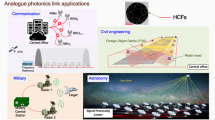Analyse
Cet article traite des études et réalisations de détecteurs HgCdTe pour télécommunications par fibres optiques, fonctionnant à 1,3 μm et à 1,55 μm en modePinou avalanche. On décrit les propriétés générales et spécifiques de Valliage HgCdTe dans la gamme de composition utile, les méthodes de préparation et de caractérisation du matériau puis les technologies utilisées. Ensuite sont décrites les performances des différents types de diodes, les tests de fiabilité, les applications et perspectives.
Abstract
This paper deal with the studies and manufacture of HgCdTe detectors for fibre optics telecommunications, operating at 1,3 μm and 1,55 μm either with thePinstructure or with the avalanche mode. Electronic properties of the HgCdTe alloy with the appropriate composition range value, crystal growth methods, means of characterization of the materiel and process technology are described. Performances of the different types of diodes are reported, together with reliability tests, applications and prospects.
Similar content being viewed by others
Références
*** Notices commerciales sat, n∘ DC 2233/5.82 à 2237/5.82. Photodiodepin HgCdTe 1,3 [xm.
Dornhaus (R.) etNimtz (G.). The properties and applications of the Hg1−xCdxTe alloy system.Solid State Physics,G. Höhler ed., Springer — Verlag, Berlin (1976),78.
Willardson (R. K.) etBeer (A. C.). Mercury cadmium telluride. Semiconductors and semimetals,Academic Press New York (1981),18.
Royer (M.). Crystal growth of narrow gap semiconductors, theory and techniques. Proc of the int. Summer School on Narrow gap semiconductors. W. Zawadzki ed. Lecture notes in Physics,Springer-Verlag (1980),133.
N’Guyen Duy (T.), Pichard (G.) et Raymond (F.). 1,3 μm HgCdTe photodetectors for fiber optics applications.Proc. FOC 80, Fiber Optics Communications 14–16 sept. 1980. San Francisco (édité parinformation Gatekeepers, Mass. USA), pp. 177–180.
Pichard (G.), Meslage (J.), Fragnon (P.) et Raymond (F.). Photodiodes HgCdTe pour télécommunications par fibres optiques à grande distance.Proc. 8°ECOC, Cannes (sept. 1982), pp. 389–393.
Meslage (J.), N’Guyen Duy (T.), Pichard (G.) etRoyer (M.). Fast high gain 1.3 μm HgCdTe photodiodes.Proc. ECOC 7th, Copenhague (sept. 81).
Verie (C.), Raymond (F.), Besson (J.) etN’Guyen Duy (T.). Bandgap spin orbit splitting resonance effect in HgCdTe alloys.J. Cryst. Growth, suppl., USA (oct. 82).
Hildebrand (O.), Kuebart (W.), Benz (K. W.) etPilkuhm (M. H.). GaAlSb avalanche photodiode: resonant impact ionization with very high ratio of ionization coefficients.IEEE J. QE, USA (fév. 81),17, n∘ 2, pp. 284–288.
Author information
Authors and Affiliations
Additional information
Etude soutenue par contratDAII n∘ 81 35 275.
Rights and permissions
About this article
Cite this article
Royer, M., Brossat, T., Fragnon, P. et al. Détecteurs HgCdTe pour télécommunication par fibres optiques. Ann. Télécommun. 38, 62–72 (1983). https://doi.org/10.1007/BF02996060
Received:
Issue Date:
DOI: https://doi.org/10.1007/BF02996060
Mots clés
- Photodétecteur
- Télécommunication optique
- Cadmium mercure tellurure mixte
- Infrarouge
- Semiconducteur
- Composé ternaire
- Photodiode
- Diode couche intrinsèque
- Diode avalanche
- Fabrication
- Caractérisation




